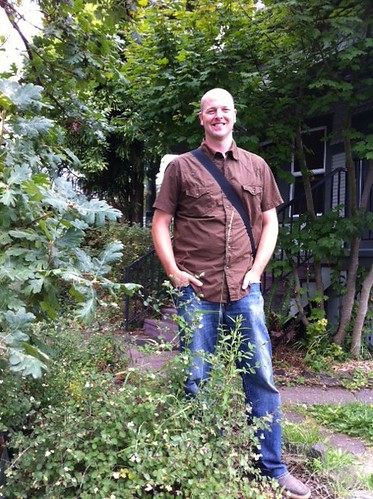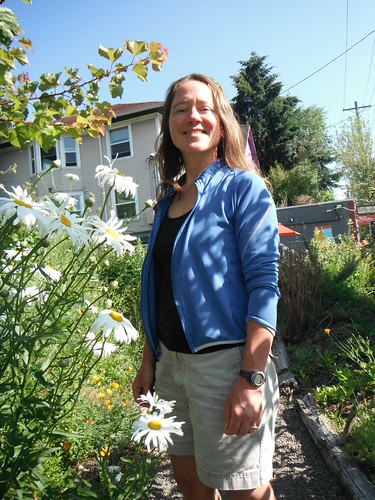Tag: G2G
What if our cities had no trees?
Why plant trees in cities? This video shows the many ways our trees can help us.
You may recognize three people in this video who have helped our Portland-Vancouver area treescape, including a Friends of Trees staff member. Many thanks to Portland Bureau of Environmental Services, Portland Parks & Recreation, and all of you who have helped make our city forests grow.
And thank you, American Forests, for all you do for urban forests across our country.
Grey or green? Portland chooses green!

Grey or green: which do you prefer?
Portland’s Bureau of Environmental Services chose “green” four years ago when it launched the Grey to Green Initiative, a commitment to invest in green infrastructure to reduce stormwater runoff and pollution in Portland’s rivers.
Last month the Friends of Trees blog featured Jennifer Karps and her role in the initiative. Today’s post focuses on the other key staff member who has made Grey to Green successful: Matt Krueger.
About ten years ago, Matt and his wife Phoebe, both University of Wisconsin graduates, loaded up a van and headed from Madison, Wisconsin, to Portland, Oregon. They had no jobs or home in mind. They just liked the city, which Matt had learned about at the University of Wisconsin, where he earned his bachelor’s degree in landscape architecture.
It didn’t take long for them to find work. Matt quickly joined a local landscape design company, where he worked for five years before joining Grey to Green.Read More
How trees clean our water

This is the second excerpt on Growth Rings from a series written by Friends of Trees Crew Leader Neva Knott about the value of city trees. In January, we published the opening story of her blog, “Why Do You Plant Trees?“
“Urban forestry is a blend of social and scientific necessity. With 80 percent of the US population living in cities, care of city trees as natural resources takes on a much broader context. As explained by the US Forest Service, ‘urban forests are dynamic ecosystems that provide environmental, social, and economic benefits.’
“Along these lines, Portland’s Climate Action Plan for Urban Forestry and Natural Systems broadens the initiatives of Grey to Green and Friends of Trees. It includes safe-guarding against tree loss during development; treating trees as part of the infrastructure of the city; putting in place codes and policies to maximize tree preservation; expansion of private and public urban forestry programs; removal of regulatory obstacles; reduction of the heat island effect caused by development. This, for sure, is a new way of thinking. Fresh, and aligned with the science of climate change as well as the ideas behind livable cities.
How Portland is turning its grey to green
What exactly is the Grey to Green Initiative?

Grey to Green is an eight-year commitment initiated in 2008 by the City of Portland’s Bureau of Environmental Services to enhance green spaces, restore watershed connectivity, create ecoroofs and bioswales, and plant trees to clean our water. The greening projects reduce the need for more concrete (or grey) construction as a way to manage stormwater and keep our rivers clean.
Three years ago the city hired two people to implement the tree-planting part of the Grey to Green Initiative: Matt Krueger and Jennifer Karps. Watch this blog to learn more about Matt Krueger’s role in Grey to Green.
As the Grey to Green canopy coordinator, Jennifer manages a three-tiered effort that includes the following: 1) working with Friends of Trees to plant trees at community volunteer events; 2) having contractors plant trees that volunteers can’t plant, such as huge trees along the freeway and street trees where the city’s rights-of-way aren’t clearly defined; and 3) offering Treebates, deductions from stormwater bills for people who plant trees at their homes.
How to plant trees and build community. Step one: Coordinate with us!
By Andy Meeks
We all know how amazing urban street and yard trees can be: they increase air and water quality, improve neighborhood livability, help mitigate stormwater, boost property values and help beautify neighborhoods. They do a ton, but they don’t plant themselves.
The first step of our volunteer-based neighborhood tree plantings starts with our Neighborhood Coordinators (NCs), the most vital connection to the neighborhoods where we plant trees. NCs are absolutely critical to the mission and success of Friends of Trees by building support among their neighbors who want to see more trees in their neighborhood. NCs work closely with staff members to help answer questions from tree purchasers, create outreach strategies, and organize planting day logistics.

And we’d love your help! Our annual Neighborhood Coordinator Training will be held on Thursday, July 12, from 6:00 pm to 8:30 pm at the Colonial Heights Presbyterian Church at 2828 SE Stephens Street in Portland. (If you are unable to make this date, please let us know and we can arrange an alternate time.)
